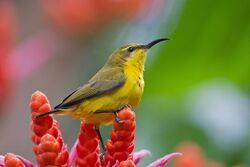Biology:Sahul sunbird
| Sahul sunbird | |
|---|---|

| |

| |
| Male above, female below | |
Not evaluated (IUCN 3.1)
| |
| Scientific classification | |
| Domain: | Eukaryota |
| Kingdom: | Animalia |
| Phylum: | Chordata |
| Class: | Aves |
| Order: | Passeriformes |
| Family: | Nectariniidae |
| Genus: | Cinnyris |
| Species: | C. frenatus
|
| Binomial name | |
| Cinnyris frenatus (Müller, S, 1843)
| |
The Sahul sunbird (Cinnyris frenatus) is a species of bird in the sunbird family Nectariniidae that is endemic to Sulawesi eastwards to New Guinea and the Soloman Islands. It is also found in northeast Australia. It was formerly considered to be a subspecies of the olive-backed sunbird, now renamed the garden sunbird (Cinnyris jugularis).
Taxonomy
The Sahul sunbird was formally described in 1843 by the German naturalist Salomon Müller based on a specimen collected on the west coast of New Guinea. He coined the binomial name Nectarinia frenata.[1][2] The specific epithet frenatus is Latin meaning "bridled".[3] The species was subsequently moved to the genus Cinnyris that had been introduced in 1816 by the French naturalist Georges Cuvier. The Sahul sunbird was formerly considered as a subspecies of the olive-backed sunbird (now the garden sunbird (Cinnyris jugularis) but is now treated as a separate species based on the differences in plumage and the mitochondrial DNA sequence.[4][5][6]
Four subspecies are recognised:[5]
- C. f. plateni (Blasius, W, 1885) – Talaud Islands (northeast of Sulawesi), Sulawesi and satellites
- C. f. robustirostris (Mees, 1964) – Banggai Islands and Sula Island (east of Sulawesi)
- C. f. frenatus (Müller, S, 1843) – Morotai to Obi Islands (north Moluccas), New Guinea (except north) and satellites (exceptTrobriand Islands, Woodlark Island and Louisiade Archipelago, southeast of New Guinea), Aru Islands (southwest of New Guinea) and northeast Queensland (far northeast Australia)
- C. f. flavigastra (Gould, 1843) – Bismarck Archipelago including Ninigo and Hermit Islands, and north, central south Solomon Islands to Guadalcanal and Malaita
Description
The Sahul sunbird is 10–11.4 cm (3.9–4.5 in) in length. The male weighs 6.7–11.9 g (0.24–0.42 oz), the female 6–10 g (0.21–0.35 oz). The species is sexual dimorphic. The male of the nominate subspecies is olive above, the remiges are black with green edging and the black tail has a white tip. The throat, side of neck, throat and breast are blue-black iridescent. It has a yellow supercilium and a yellow moustachial stripe. The iris is dark brown and the legs are black. The female lacks the iridescent throat patch.[7]
Distribution and habitat
The Sahul sunbird is a resident species from Sulawesi and the Maluku Islands to New Guinea, the Aru Islands, the Bismarck Archipelago, northern Solomon Islands and northeastern Australia.[5] It is found in various habitats including mangroves, forest edge, open scrub as well as parks and gardens.[7]
Behaviour and ecology
Breeding
The elongated hanging nest is built by the female. It is 30–60 cm (12–24 in) in length and has a side entrance. The clutch of 1–3 eggs is incubated by the female and hatch after 11–16 days. The young are fed by both parents until they fledge when aged 13–16 days.[7]
Feeding
It forages either singly or in small groups. The diet consists of small insects, spiders, nectar and small fruit.[7]
References
- ↑ Müller, Salomon (1843) (in Dutch). Verhandelingen over de natuurlijke geschiedenis. 1: Land-en Volkenkunde. Leiden: In commissie bij. S. en J. Luchtmans en C.C. van der Hoek. p. 173, Footnote. https://www.biodiversitylibrary.org/page/56902011. For the publication date see: Husson, A.M.; Holthuis, L.B. (1955). "The dates of publication of "Verhandelingen over de natuurlijke Geschiedenis der Nederlandsche overzeesche Bezittingen" edited by C. J. Temminck". Zoologische Mededelingen 34 (2): 17–24. https://repository.naturalis.nl/pub/318953.
- ↑ Paynter, Raymond A. Jr, ed (1986). Check-List of Birds of the World. 12. Cambridge, Massachusetts: Museum of Comparative Zoology. p. 247. https://www.biodiversitylibrary.org/page/14482364.
- ↑ Jobling, James A. (2010). The Helm Dictionary of Scientific Bird Names. London: Christopher Helm. p. 164. ISBN 978-1-4081-2501-4. https://archive.org/stream/Helm_Dictionary_of_Scientific_Bird_Names_by_James_A._Jobling#page/n164/mode/1up.
- ↑ Ó Marcaigh, F.; Kelly, D.J.; O’Connell, D.P.; Analuddin, K.; Karya, A.; McCloughan, J.; Tolan, E.; Lawless, N. et al. (2023). "Small islands and large biogeographic barriers have driven contrasting speciation patterns in Indo-Pacific sunbirds (Aves: Nectariniidae)". Zoological Journal of the Linnean Society 198 (1): 72–92. doi:10.1093/zoolinnean/zlac081.
- ↑ 5.0 5.1 5.2 Gill, Frank; Donsker, David; Rasmussen, Pamela, eds (December 2023). "Dippers, leafbirds, flowerpeckers, sunbirds". IOC World Bird List Version 14.1. International Ornithologists' Union. https://www.worldbirdnames.org/bow/ovenbirds/.
- ↑ Cheke, R.; Mann, C.; Kirwan, G.M.; Christie, D.A. (2023). "Sahul Sunbird (Cinnyris frenatus), version 1.0". in Keeney, B.K.; Billerman, S.M.. Birds of the World. Ithaca, NY, USA: Cornell Lab of Ornithology. https://doi.org/10.2173/bow.olbsun2.01.
- ↑ 7.0 7.1 7.2 7.3 Cheke, R.A.; Mann, C.F. (2008). "Family Nectariniidae (Sunbirds)". in del Hoyo, J.; Elliott, A.; Christie, D.A.. Handbook of the Birds of the World. 13: Penduline-tits to Shrikes. Barcelona, Spain: Lynx Edicions. pp. 196-321 [296-297]. ISBN 978-84-96553-45-3. https://archive.org/details/handbookofbirdso0013unse/page/296/mode/1up.
Wikidata ☰ {{{from}}} entry
 |


